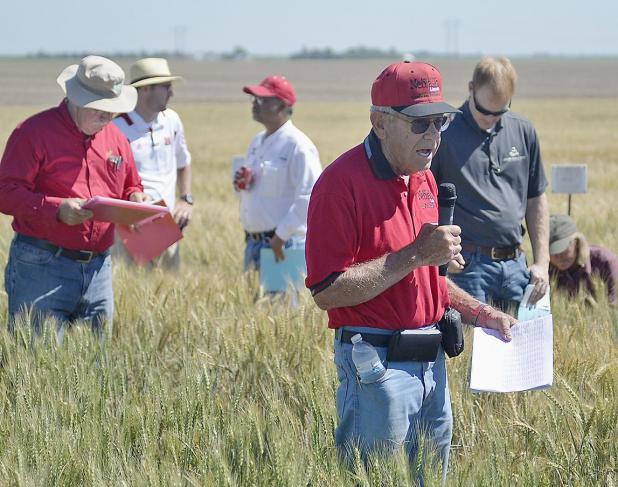
Western Nebraska Crop Specialist Bob Klein of North Platte talks with attendees at last week’s field day at the Stumpf Wheat Center. University Wheat Breeder Steve Baenziger, left, looks at notes before briefing the crowd on the various wheat varieties in trials at the center. (Johnson Publications photo)
Wheat trial yields at Stumpf center among best in state
Editor’s note: This is the first of two stories looking at the research work on wheat and field peas at the Henry J. Stumpf International Wheat Center in Grant.
University of Nebraska Crop Specialist Bob Klein of North Platte couldn’t be prouder of the crop research being done at the Henry J. Stumpf International Wheat Center at Grant.
Over the first two years of wheat variety trials at the center, yields in test plots were among the top in the state.
He told the crowd of nearly 100 people attending the Extension’s field day at the wheat center Tuesday, June 20 that yields at the center averaged 64.5 bushels/acre (bu/a).
That figure tied with a plot trial in Furnas County. He said those results are amazing, considering the center is only in its third year of operation.
In 2015, the center’s wheat trial yields averaged 49 bu/a with a high of 62 bu/a.
In 2016, yields averaged 80 bu/a with a high of 91 bu/a.
He said they achieved the highest yield ever on a plot in Furnas County last year, with a high of 107 bu/a and an average of 91 bu/a.
Attendees at last week’s field day got an up-close look at the various wheat trials the center is conducting this year.
Many of the varieties are in their third year of trials, along with experimental varieties being studied at the center.
Strahinja Stepanovic, the center’s cropping specialist, said there are more than 45 varieties in this year’s yield trials. These include both university and commercial varieties from Nebraska, Kansas and Colorado.
He estimated there are more than 1,200 individual plots, measuring five feet by 25 feet, at the center.
He said they replicate each plot as many as five times to test each variable. These include planting date, seeding rate, fertilizer application, fungicide application for disease prevention and pre-planting seed treatment.
Stepanovic noted the university and the center are also partners with several other seed developers on their own respective trials and wheat seed breeding.
Leading wheat varieties
Steve Baenziger, Ph.D., the university’s leading wheat and small grains breeder, took participants through a plot-by-plot review of the more than 40 varieties in this year’s trial at the center.
He was especially high on a new university breed known as Ruth.
In the west central dryland tests the past two years, Baenziger said it has yielded exceptionally well, averaging 72 bu/a with average protein of 13.4 percent.
In addition, the variety shows excellent resistance to stem rust and moderate resistance to stripe leaf rust.
He said a limited amount of seed will be available for planting this fall.
Another Husker Genetic breed that’s done well is Freeman, he noted.
The variety displays exceptional winter hardiness and makes the most efficient use of nitrogen in the trials.
It averaged 73 bu/a with average protein at 13.2 percent.
Baenziger said the variety has some Kansas and Oklahoma pedigree that helps a farmer diversify genetics.
Baenziger favors another university variety, Robidoux, because of its drought resistance, especially in dryland conditions.
He said the wheat can be irrigated but told producers to expect yields in the 90-100 bu/a range. He said other varieties offer better production under irrigation.
Among the commercially-developed varieties, Monument has proved to be the highest yielding red winter wheat in the two- and three-year trials.
Genetics important
As a wheat breeder, Baenziger urged producers to look at the genetics behind each seed variety.
He and other breeders are breeding in key genes for disease and drought resistance, standability, yield and quality, among other things.
However, that process takes place over years of research and field trials.
The genetics of a variety can prove key in controlling diseases, such as stem rust and leaf stripe rust.
Even with breeding, not all disease can be controlled. In the cases of rust, Klein advised farmers to spray for the disease right away after it’s found—the sooner the better.
By using a foliar fungicide, applied with either aerial or ground sprayer application, the plant can be protected, which in turn protects yield potential.
He said the fungicide is relatively inexpensive, ranging from $1.30-1.40 per acre, plus application.
The yield difference between fields sprayed and those that aren’t is significant, he said. That alone should make it an easy decision to spray, he added.
To view more please log in or subscribe to the digital edition. https://etypeservices.com/Imperial%20RepublicanID359/
